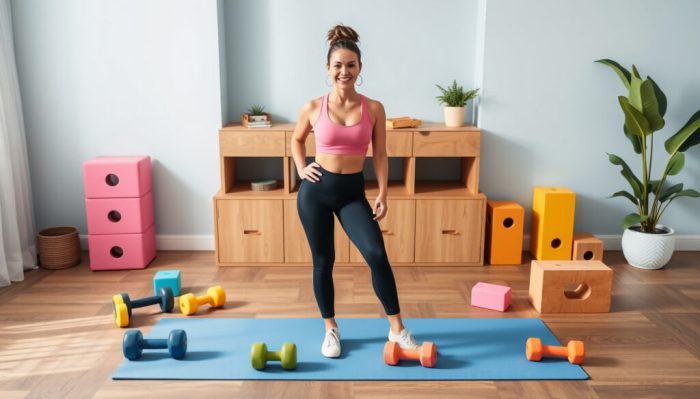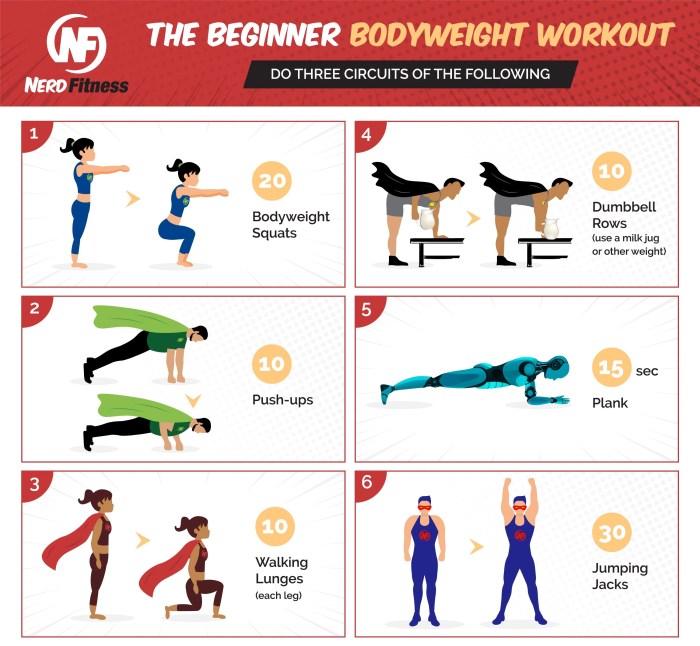Home Workout Routines take the spotlight in this guide tailored for fitness enthusiasts looking to break a sweat without leaving the house. From the perks of working out at home to crafting a killer exercise plan, this comprehensive overview has you covered.
Dive into the world of home fitness and discover how you can achieve your health goals without stepping foot in a gym.
Benefits of Home Workout Routines
Working out at home comes with a plethora of advantages that make it a popular choice for many fitness enthusiasts. Not only does it offer convenience and flexibility, but it also helps in saving both time and money compared to traditional gym memberships.
Time-Saving
Exercising at home eliminates the need to commute to a gym, saving valuable time that can be utilized for other activities. With no travel time, you can jump right into your workout, making it easier to stick to a consistent routine.
Cost-Effective
Home workouts are a budget-friendly alternative to expensive gym memberships. You can invest in basic equipment like dumbbells or resistance bands once and use them for a long time, avoiding recurring monthly fees.
Flexibility in Scheduling
One of the biggest perks of home workout routines is the flexibility to exercise at any time that suits your schedule. Whether you prefer early morning sessions or late-night sweat sessions, you have the freedom to work out whenever it’s convenient for you.
Types of Home Workout Routines

When it comes to home workout routines, there are various types you can choose from to stay fit and healthy. These routines can be adapted to suit your preferences and fitness goals.
HIIT Workouts
HIIT, or High-Intensity Interval Training, is a popular workout style that involves short bursts of intense exercise followed by brief rest periods. These workouts are great for burning calories and improving cardiovascular fitness.
- Example: 30 seconds of jumping jacks followed by 10 seconds of rest, repeated for multiple rounds.
Yoga
Yoga is a fantastic way to improve flexibility, strength, and mental well-being. It can easily be done at home with just a yoga mat and some online tutorials or apps to guide you through the poses.
Bodyweight Exercises
Bodyweight exercises are a simple yet effective way to build strength and muscle without needing any equipment. These exercises utilize your body weight as resistance.
- Adaptation: Replace the leg press machine at the gym with squats or lunges at home to target the same muscles.
Equipment Needed
While many home workout routines can be done with just your body weight, having some basic equipment can add variety and challenge to your workouts:
- Dumbbells: Great for adding resistance to exercises like bicep curls, shoulder presses, and lunges.
- Resistance Bands: Provide versatile resistance for various exercises, such as banded squats or rows.
- Yoga Mat: Essential for comfort and stability during yoga or floor exercises.
- Pull-Up Bar: Ideal for targeting back and arm muscles with exercises like pull-ups and chin-ups.
Creating an Effective Home Workout Plan
To achieve success with your home workout routine, it’s crucial to create a well-thought-out plan that includes a variety of exercises to target different areas of fitness. Here’s how you can design an effective home workout plan:
Setting Realistic Fitness Goals
Setting realistic fitness goals is essential to stay motivated and track your progress effectively. Start by determining what you want to achieve, whether it’s weight loss, muscle gain, improved endurance, or flexibility. Break down your goals into smaller milestones that are attainable within a specific timeframe. Remember to be realistic about your starting point and the time it will take to reach your desired fitness level.
Incorporating Strength Training, Cardio, and Flexibility Exercises
A well-rounded home workout plan should include a mix of strength training, cardio, and flexibility exercises. Strength training helps build muscle mass and improve overall strength, while cardio exercises are essential for boosting cardiovascular health and burning calories. Flexibility exercises such as yoga or stretching can help improve range of motion and prevent injuries. Incorporating all three types of exercises will ensure a balanced fitness routine.
Tips for Designing a Well-Rounded Home Workout Routine
Schedule your workouts
Set aside dedicated time each day for exercise to establish a consistent routine.
Mix up your exercises
Include a variety of workouts to keep things interesting and challenge different muscle groups.
Use bodyweight exercises
If you don’t have access to equipment, bodyweight exercises can be just as effective for strength training.
Monitor your progress
Keep track of your workouts, reps, and weights used to track improvements and make adjustments to your routine.
Stay hydrated and eat well
Proper nutrition and hydration are key components of a successful workout plan to fuel your body and aid in recovery.By following these tips and incorporating a variety of exercises into your home workout routine, you can create an effective plan that helps you reach your fitness goals.
Motivation and Accountability in Home Workouts: Home Workout Routines

Staying motivated and holding yourself accountable are key factors in maintaining a successful home workout routine. Without the structure of a gym or a personal trainer, it can be challenging to stay on track and push yourself to reach your fitness goals. Let’s explore some strategies to keep you motivated and accountable while working out at home.
Setting Clear Goals
Setting specific, measurable, achievable, relevant, and time-bound (SMART) goals can help keep you motivated during home workouts. Whether it’s aiming to run a certain distance, increase your strength, or improve your flexibility, having clear goals in mind can give you something to work towards and celebrate once achieved.
Creating a Workout Schedule
Establishing a workout schedule and sticking to it can help create a sense of routine and discipline in your home workouts. By setting aside dedicated time for exercise each day or week, you are more likely to stay consistent and motivated to follow through with your workouts.
Accountability Partners and Online Communities, Home Workout Routines
Engaging with accountability partners or joining online fitness communities can provide the support and motivation you need to stay on track with your home workouts. Whether it’s checking in with a friend, sharing progress updates on social media, or participating in virtual workout challenges, having a support system can help hold you accountable and keep you motivated.
Tracking Progress and Celebrating Achievements
Keeping track of your progress, such as recording your workouts, tracking your measurements, or monitoring your fitness improvements, can help you see how far you’ve come and stay motivated to continue. Celebrating small victories along the way, whether it’s reaching a new personal best or completing a challenging workout, can boost your morale and keep you motivated to push further in your fitness journey.
